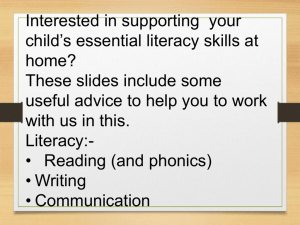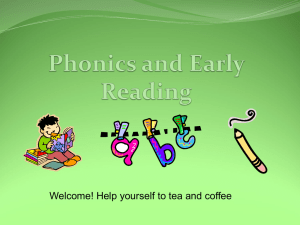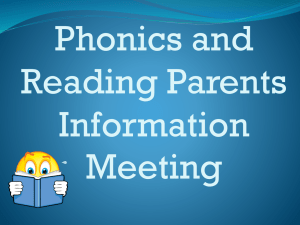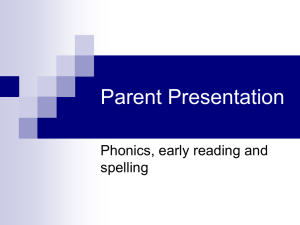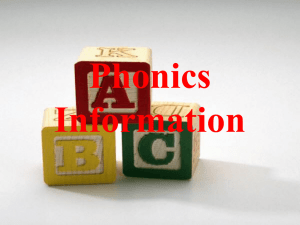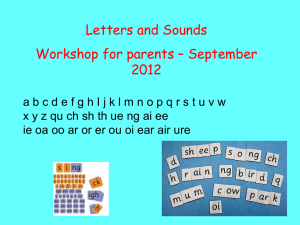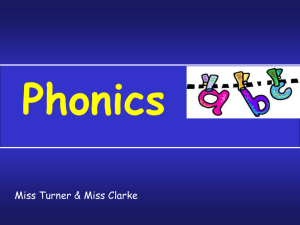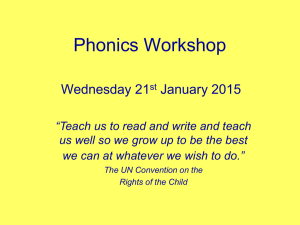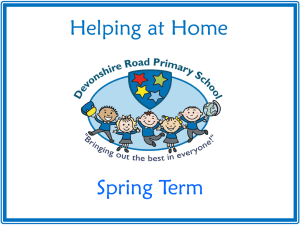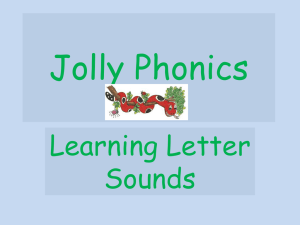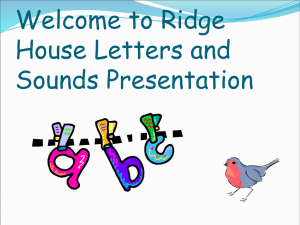Phonics Workshop for Parents: Letters and Sounds Guide
advertisement
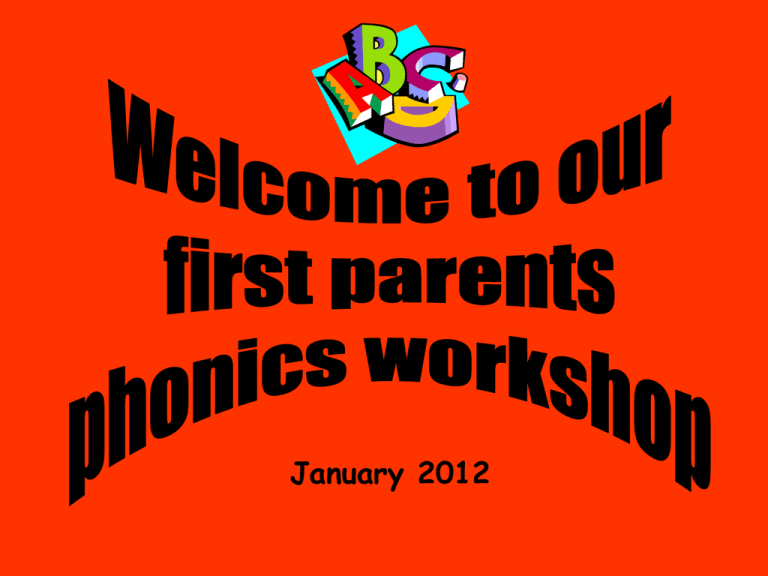
January 2012 •Past results and data •School development plan 2011/12 •Government initiative •OFSTED focus •Year 1 phonics check •Understand more about what phonics is and how we teach it at school •Not to scare you – handouts will be a reference for you with some of the hard language involved with phonics •To give you practical ideas on games and activities you can be playing at home with your children •For you to feel more confident in supporting us in teaching your child to read letters, words, sentences and texts Reception Covers Phases 1, 2 and 3 Year 1 Covers Phases 4 and 5 Letters and Sounds Phase 0ne Phase One aspects • • • • • • • Environmental sounds Instrumental sounds Body percussion Rhythm and rhyme Alliteration Voice sounds Oral blending and segmenting Environmental Sounds • Listening walks (indoors and outdoors) • Drumming outdoors • Sound lotto • Singing phonics Instrumental sounds • Match the sound • Which instrument? • Music to story Body Percussion • Action songs • Sounds made by different parts of body • Pass the sound around the circle Rhythm and rhyme • Silly soup game • Nursery rhymes and songs • Playing with words • Repetitive stories Alliteration • Digging for treasure • Same sound sentences Voice sounds • Mouth movements • Mr Tongue story • Voice cards visual cards • Voice change Oral blending and segmenting • Adult begins to model oral blending e.g. get your h-a-t • I spy • Sound talk across the river game Phase One was designed to help children to: • • • • • Listen attentively Enlarge vocabulary Speak confidently Discriminate phonemes Reproduce audibly the phonemes they hear Phonics Phase 2 and 3 Reception Phase 2 • Is the start of systematic phonic work. • Begins the understanding of grapheme- phoneme correspondence. • Understand that words are constructed from phonemes and that phonemes are represented by graphemes. Phonemes A Phoneme is the smallest unit of sound in a word. s a t p i n m d g o c k ck e u r h b f ff l ll ss Pronouncing the phonemes correctly is very important. eg the letter s is pronounced sssss and not suh. We all need to use the same language at home and at school. Next steps … • Children then begin to blend for reading. • Starting with simple VC (vowel consonant) words e.g at, it, is • and then to CVC (consonant vowel consonant) words. E.g dog, cat, man BLENDING • Recognise and say the letter sounds in a written word, for example: s-a-t by merging or ‘blending’ them in the order in which they are written to pronounce the word ‘sat’. Segmenting Activity • How many phonemes in each word? shelf sh- e- l- f dress d- r- e- ss sprint s- p- r- i- n- t string s- t- r- i- ng 4 phonemes 4 phonemes 6 phonemes 5 phonemes Phase 3 • Completes the teaching of the alphabet and children move onto sounds represented by more than 1 letter. • DIGRAPHS – 2 letters that make 1 sound ll ss zz oa ai • TRIGRAPHS – 3 letters that make 1 sound igh air Phase 3 phonemes j v w y z zz qu ch sh th ng ai ee igh oa oo oo ar or ur ow oi ear air ure er TRICKY WORDS • Words that are not phonically decodable. • e.g. was, the, I. • Some are ‘tricky’ to start with but will become decodable once we have learned the harder phonemes. • e.g. out, there. Now you have the knowledge…. • Play lots of sound and listening games with your child. For Example… I spy. Use the sound tins school provides to make words (real and nonsense ones) sounding them out. Make duplicate sounds and play pairs… matching games. Stick sounds on items that start with that letter sound. At home, on car journeys, outings ask children to find as many things they can that start with a sound chosen. Let them hear sounds… sound talk to them. “Fetch me your c-oa-t”! • Read as much as possible to and with your child. • Encourage and praise – get them to have a ‘good guess’. • Ask if you want to know more. Make it fun and in short, sharp bursts! Phase 4 and Phase 5 Phase 4 • In Phase 4, no new graphemes are introduced. The main aim of this phase is to consolidate the children's knowledge and to help them learn to read and spell words which have adjacent consonants, such as trap, string and milk. • Phase 4 is generally started at the beginning of Year 1, but may sometimes be covered at the end of YR then recapped at the start of Y1. Phase 4 Tricky words During Phase 4, the following tricky words (which can't yet be decoded) are introduced: said have like so do some come were there little one when out what Phase 5 • In Phase Five, children will learn more graphemes and phonemes. For example, they already know ai as in rain, but now they will be introduced to ay as in day and a-e as in make. • Alternative pronunciations for graphemes will also be introduced, e.g. ea in tea, head and break. Phase 5 is a long unit, taught throughout Year 1. Game ideas Shooting Stars Pick sounds you are working on / have worked on. Write the graphemes on cards and give out. Sit in a circle, call out words and if the child has the grapheme that matches the phomeme in the word they must come and sit in the chair. Countdown (Taken from support for spelling Phase 5 games) Have a focus phoneme. Give children a selection of sounds. Give them one minute to make the best word they can. s g n t ai r h p e Word sort games y for ‘ee’ y for ‘igh’ y for ‘y’ y for ‘i’ Word sort games y for ‘ee’ plenty family puppy simply y for ‘igh’ my why satisfy y for ‘y’ yes yet y for ‘i’ synthetic The Name Game Have a focus phoneme. Ask the children to find words containing the phoneme that fit into the category. Gain one point for every name they spell correctly. Country Fruit Boy’s name Girl’s name The Name Game Have a focus phoneme. Ask the children to find words containing the phoneme that fit into the category. Gain one point for every name they spell correctly. Country Fruit Boy’s name Girl’s name Wales Grape James Jane
